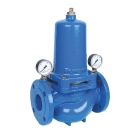Honeywell D15S diaphragm-actuated pressure-reducing valve

Honeywell has released the D15S pressure reducing valve for residential, commercial and industrial potable-water applications.
Multi-occupied residential properties such as apartment buildings and hotels are an important application for this type of pressure-reducing valve. Excessive water pressure can not only cause damage to the water-distribution system and ancillary equipment but also be the source of noise annoyance to occupants.
High water velocity in pipes and fittings caused by excessive pressure can also generate vibration-associated impact sounds and in some circumstances result in ‘pipe hammer’. This is particularly true of multi-occupier residential buildings where high-velocity water flow through pipework can be a continual source of complaint from apartment owners and tenants.
Inlet supply pressure can vary significantly over a 24-hour period as the water utility grid is affected by demand. If there is no adequate pressure regulation within the building, the fluctuations in grid supply pressure are transmitted directly on pipework, fittings and connected appliances.
It is therefore essential that a high-quality pressure-reducing or regulating valve is installed as a part of the inlet-water control set on the utility connection. A pressure-reducing valve must be capable of stabilising outlet pressure irrespective of the variation of inlet pressure and downstream usage within the valve’s specification.
The Honeywell D15S is a diaphragm-actuated spring-loaded pressure-reducing valve that operates by means of a force-balancing system where the force of the diaphragm operates against the force of the adjustment spring.
When the outlet pressure acting on the diaphragm equals the spring force, the system is in balance and the outlet pressure is maintained.
If the outlet pressure falls below the adjusted setting because there is a water draw off, the force acting on the diaphragm decreases, allowing the greater force of the spring to open the valve.
The outlet pressure then increases until the forces between the diaphragm and the spring are equal again, thus maintaining the adjusted outlet pressure.
The D15S range of valves has a maximum inlet pressure of 16 bar (PN16), an adjustable outlet pressure of 1.5 to 6.5 bar with a minimum pressure drop of 1 bar.The maximum operating temperature is 65°C.
These valves are available in nominal sizes of DN65, DN80 and DN100 with flange fitting to PN 16, ISO7005-2 EN1092-2.
The growth of multi-occupancy buildings to address the housing shortage and provide medium and high-end residential properties has focused attention on the need to ensure adequate wholesome water services in terms of pressure and flow capacity.
Distribution systems need to be carefully designed to ensure that pressure stability is controlled at the utility inlet, each floor and each individual residences. Staged pressure reduction throughout the pipework layout provides a balanced system that delivers the water service with adequate water volume and pressure, ensuring minimum noise and maximum economy.
The D15S is suitable for utility inlet and floor applications with pipe sizes from DN100 down to DN65. The popular Honeywell D06F pressure-reducing valves can manage each floor and each individual apartment with sizes available from DN50 down to DN15.
Wholesome water supply, storage and distribution is arguably the most critical building service in terms of safety, hygiene and health — with economy of usage an important consideration with the ever increasing utility cost.
To address the demands and requirements of effective water management, Honeywell has a complete portfolio of water-control products to complement its extensive range of pressure-reducing valves including pilot-operated control valves, backflow preventers, thermostatic mixing valves, thermal balancing valves and backwash filters to prevent contamination of the inlet supply.
If you would like to have further information on Honeywell’s water controls products please visit the link below.







